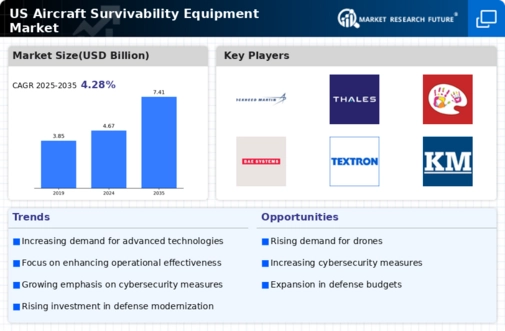Integration of Advanced Technologies
The integration of advanced technologies into the aircraft survivability-equipment market is a significant driver of growth. Innovations such as artificial intelligence (AI), machine learning, and advanced sensor technologies are transforming how survivability systems are designed and implemented. These technologies enable real-time threat assessment and response, enhancing the effectiveness of existing equipment. For instance, AI-driven systems can analyze vast amounts of data to predict potential threats, allowing for proactive measures. The U.S. Department of Defense is investing heavily in these technologies, with funding allocations reaching upwards of $10 billion in recent years. This investment is likely to accelerate the development of next-generation survivability equipment, making it a critical focus area for defense contractors.
Regulatory and Compliance Requirements
Regulatory and compliance requirements play a crucial role in shaping the aircraft survivability-equipment market. The U.S. government mandates stringent standards for military aircraft, necessitating the incorporation of advanced survivability features. Compliance with these regulations ensures that aircraft can withstand various threats, thereby enhancing operational readiness. The Federal Aviation Administration (FAA) and the Department of Defense (DoD) continuously update these standards to address evolving threats. As a result, manufacturers are compelled to innovate and upgrade their equipment to meet these requirements. This dynamic creates a consistent demand for new survivability solutions, contributing to market growth. The market is expected to expand as companies invest in research and development to align with regulatory changes.
Emerging Threats and Security Challenges
The aircraft survivability-equipment market is increasingly driven by the emergence of new threats and security challenges. As geopolitical tensions rise, the need for advanced protective measures becomes paramount. The U.S. military is focusing on countering sophisticated adversaries, which necessitates the development of cutting-edge survivability equipment. This includes systems designed to protect against advanced missile threats and cyber warfare. The market is projected to grow as defense contractors innovate to meet these challenges, with estimates suggesting a growth rate of approximately 5.5% annually over the next five years. This trend indicates a robust demand for enhanced survivability solutions, ensuring that military aircraft can operate effectively in contested environments.
Increased Focus on Training and Simulation
The increased focus on training and simulation within the aircraft survivability-equipment market is noteworthy. As military operations become more complex, the need for effective training solutions that incorporate survivability tactics is essential. The U.S. military is investing in advanced simulation technologies that allow pilots and crew to experience realistic scenarios involving potential threats. This training enhances their ability to utilize survivability equipment effectively in real-world situations. The market for simulation-based training solutions is projected to grow significantly, with estimates indicating a potential increase of 7% annually. This trend underscores the importance of preparing personnel to operate advanced survivability systems, thereby driving demand for innovative training solutions.
Collaboration Between Public and Private Sectors
Collaboration between public and private sectors is emerging as a key driver in the aircraft survivability-equipment market. The U.S. government is increasingly partnering with private defense contractors to leverage their expertise in developing advanced survivability technologies. This collaboration facilitates knowledge sharing and accelerates innovation, enabling the rapid deployment of new systems. Public-private partnerships are often supported by government funding initiatives, which can reach millions of dollars for specific projects. Such collaborations not only enhance the capabilities of military aircraft but also stimulate economic growth within the defense sector. The market is likely to benefit from these partnerships, as they foster a more agile and responsive development environment for survivability equipment.






















Leave a Comment